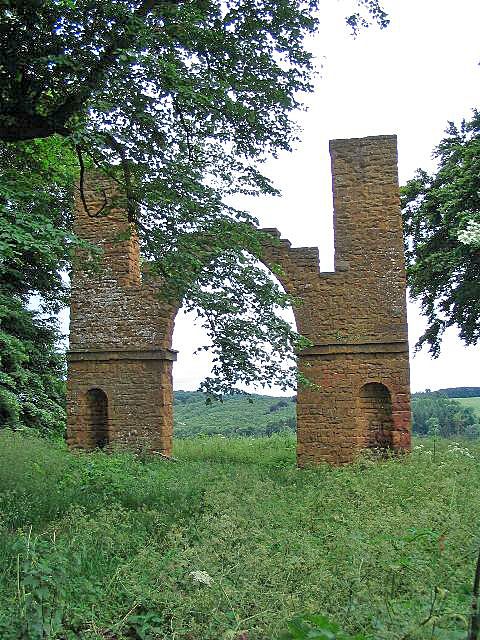Wroxton Follies
Banbury, Oxfordshire
|

Quick Guide
See below grid for details |
3 follies and an impressive house and grounds
that are now a College. The follies can be visited on a foot path.

Picture by
E Gammie


Wroxton follies are near Wroxton Abbey, they
can be seen by following a footpath. The following table gives details of what
you will see along the route.
| Grid ref |
Item |
Description |
|
SP414417 |
Wroxton Abbey
|
Wroxton Abbey
is a 17th century Jacobean mansion, built in ochre Horton stone, with
slate-roofed gables and at least twelve chimneys, with 45 bedrooms, a
chapel, a great hall and a library. It is
built on the foundations of a 13th century Augustinian monastery and is
thought to have been erected in the 1600's, by William Pope.
It
has a landscaped garden by Tilleman Bobart, created in
1728. Between 1731-1751, the garden was partly converted into a Serpentine
style, possibly to the design of Lord North, later to become the
Earl of Guildford. This centred upon 2 lakes, these being divided
by a cascade and rocaille, and a twisting serpentine river. There
is also a routine, Roman Doric Temple, with a classic 4 column
portico. In
the twentieth century, a pretty knot garden was also added.
The
Abbey is now converted into a Fairleigh Dickinson College, where
American students study.
|
| |
Footpath start |
Dark Lane, 100 yards up the road from the Abbey's front gates. |
|
SP415416 |
Wroxton Dovecote |
The
Wroxton Dovecote is a somewhat dumpy, octagonal tower in
a Gothic style, with battlements. It is sometimes referred to as
the Wroxton Castle.
Built
by Sanderson Miller, a local architect 1716-1780, he was a pioneer
of Gothic Revival architecture. He had inherited Radway Grange a few miles away. Miller is noted as being one of the great folly
builders, his many other works include the mock sham castles at Hagley Hall, and at Wimpole Hall in Cambridgeshire. Finished
in 1745, this little neo-Gothic Dovecote folly tower overlooks the
front drive of the Abbey. Mr. Miller constructed it from large bricks
of varying sizes in sandstone, the structure rising about 35ft to a viewing platform.
|
|
SP419412 |
Wroxton Obelisk |
The
Wroxton Obelisk, is around 50ft high. It is square, and tapers off to a pyramid. It was
commissioned by Francis North, the Earl of Guildford, to commemorate
the visit to Wroxton and the Banbury races, by the Prince of
Wales, Frederick of Hanover in 1739. |
|
SP428410 |
Wroxton
Arch or Drayton Arch |
The
Wroxton Arch or Drayton Arch, as it is also known, 2
40ft towers with an arch between. It is said to be one of the finest eye
catchers, or "notable object", follies in England. It is positioned in a
clearing placed at the summit of a hill, It allows the visitor
commanding views back across the fields to the Obelisk and, probably
before the trees grew up, a view to the Abbey. |
|
Page Ref:
Wroxton_Follies |
Classification:
Follies |
Date Updated: 10/2008 |
|

|
This page is a Quick Guide, the idea of Quick
Guides is to allow very basic information and linking forward information to be
added to the system rather than having to wait until a full location guide has
been developed. It should therefore be considered a development stage rather
than a finished objective. Once more information is known the objective is to
create either a Location or Featured Location page which has two grids and far
more information.
Please let us know any other information that we
can add to the Grid(s) or page and any errors that you discover. Before making a long trip to any location it is always
wise to double check the current information, websites like magazines may be
correct at the time the information is written, but things change and it is of
course impossible to double check all entries on a regular basis. If you have
any good photographs that you feel would improve the illustration of this page
then please let us have copies. In referring to this page it is helpful if you
quote both the Page Ref and Classification from the Grids above. To print the
planning grid select it then right click and print the selected area.
Please submit information on locations you discover so
that this system continues to grow.
|